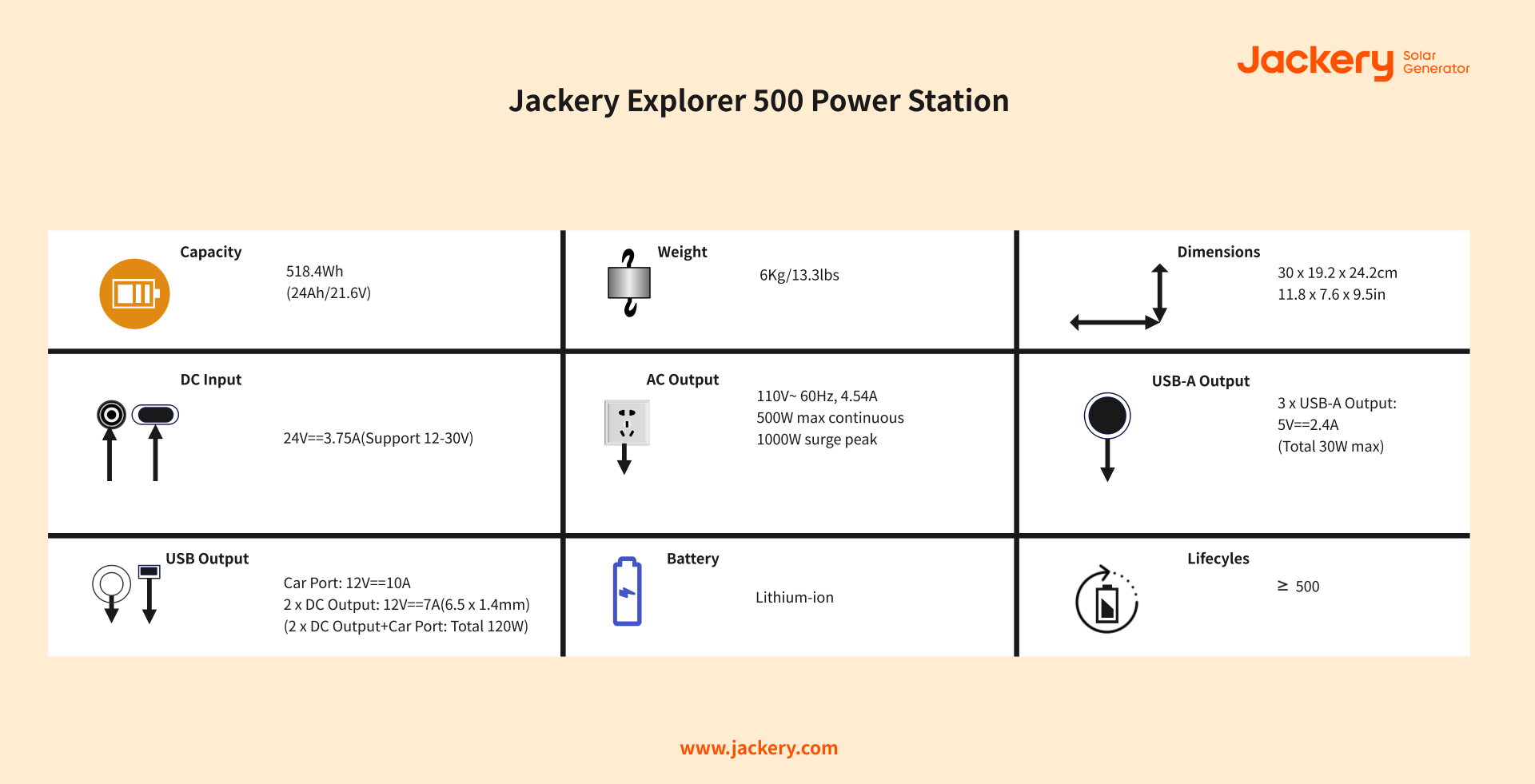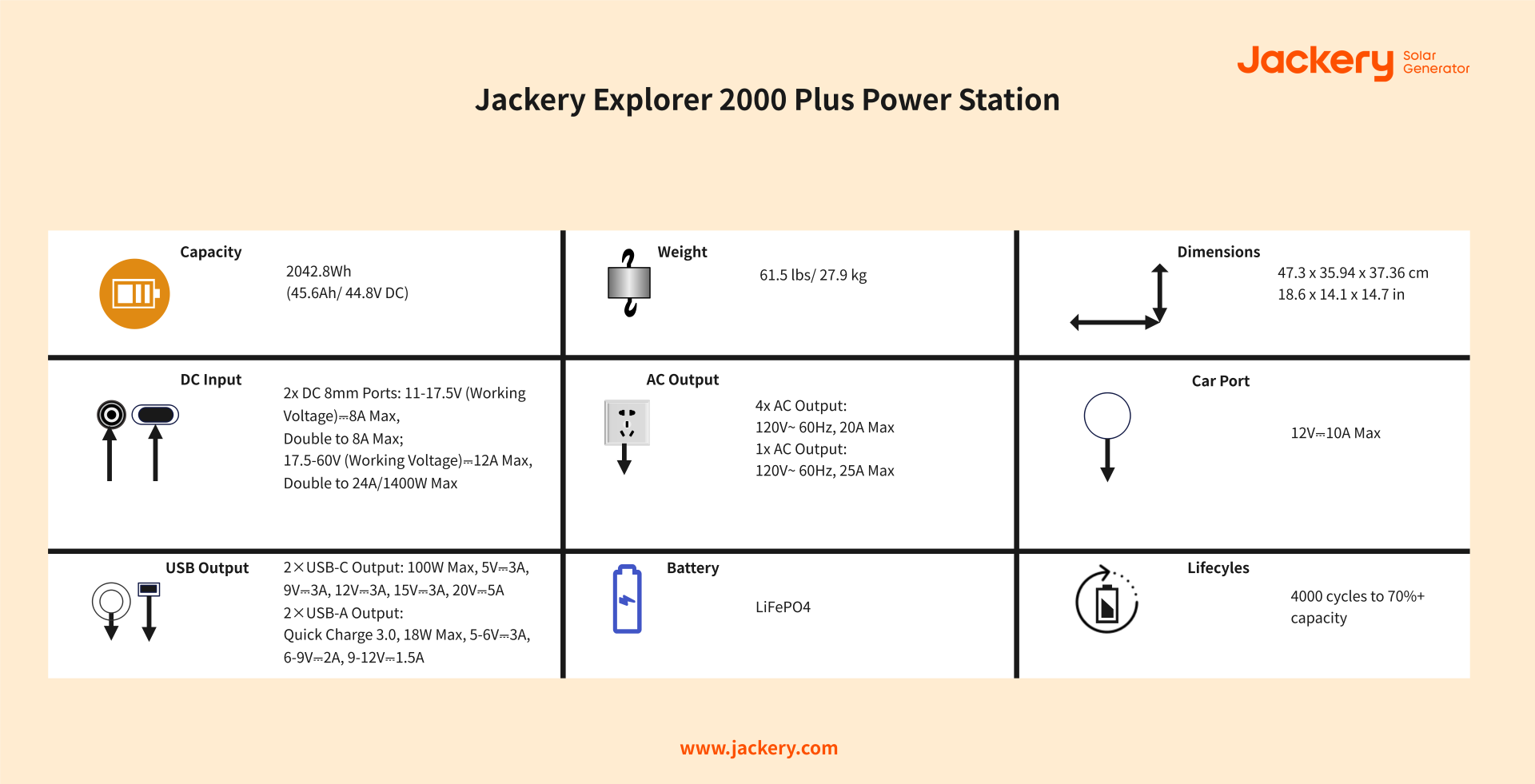Understanding batteries has never been easier, but the battery voltage charts can help you learn about the relationship between a battery's voltage and its charge state. These charts act as an important tool to understand how a battery's components work, so you can optimize the battery's performance and extend its lifespan. However, the battery voltage chart varies depending on the type of batteries you are using.
Jackery Portable Power Stations are ideal charging solutions for your household or outdoor appliances. They feature efficient and reliable batteries, such as NMC and LiFePO4. The upgraded BMS technology helps you safely charge appliances without equipment damage due to voltage or circuit fluctuations. In this guide, we will reveal the battery voltage charts of different popular batteries, including lead-acid, deep cycle, LiFePO4, and AGM.
What Is Battery Voltage Chart
The term "battery voltage" represents the electrical potential difference between any battery's positive and negative terminals. The battery voltage is crucial because it determines the power or energy your battery can supply, its charge state, and the voltage required for certain electronics.
Battery voltage charts describe the relation between the battery's charge state and the voltage at which the battery runs. These battery charging voltages can range from 2.15V per cell to 2.35V per cell, depending on the battery type. You can check or read a battery's voltage using a multimeter.
Here's a 12V battery chart that reveals the relationship between the charging state, voltage, and specific gravity hydrometer.
|
Percentage of Charge |
12V Battery Voltage |
Specific Gravity using Hydrometer |
|
100% |
12.70 |
1.265 |
|
95% |
12.64 |
1.257 |
|
90% |
12.58 |
1.249 |
|
85% |
12.52 |
1.241 |
|
80% |
12.46 |
1.233 |
|
75% |
12.40 |
1.225 |
|
70% |
12.36 |
1.218 |
|
65% |
12.28 |
1.204 |
|
55% |
12.24 |
1.197 |
|
50% |
12.20 |
1.190 |
|
45% |
12.16 |
1.183 |
|
40% |
12.12 |
1.176 |
|
35% |
12.08 |
1.169 |
|
30% |
12.04 |
1.162 |
|
25% |
12.00 |
1.155 |
|
20% |
11.98 |
1.148 |
|
15% |
11.96 |
1.141 |
|
10% |
11.94 |
1.134 |
|
5% |
11.92 |
1.127 |
|
0% (Discharged) |
11.90 |
1.120 |
The Type of Batteries
The battery voltage chart differs depending on the type of battery. Below we'll reveal five different types of batteries.
Lead-Acid: These battery types are economical and extremely popular choices. The heavy and bulkier batteries sometimes leak, making the device unusable.
Lithium-ion: These commonly used battery types have a superior energy density and can store more energy than others. These lightweight batteries are designed for portable devices.
Deep Cycle: A deep-cycle battery is designed to be regularly deeply discharged using its maximum capacity. It has thicker active plates, thicker separators, and higher-density active paste material.
LiFePO4: Also known as lithium iron phosphate or LFP battery, it offers increased power output, reduced weight, longer lifetime, and faster recharging.
AGM: AGM (Absorbent Glass Mat) is an advanced lead-acid battery type. The battery contains positive and negative lead and lead oxide plates that release electrons.
What Is State of Charge and Discharge Chart
State of charge (SoC), usually represented in percentage, is the charge level of an electric battery relative to its capacity. Battery's SoC can be quickly determined by reading either specific electrolyte gravity or terminal voltage.
State of Charge and Discharge Chart
|
State of Charge |
Sealed or Flooded Lead Acid battery voltage |
Gel battery voltage |
AGM battery voltage |
|
100% |
12.70+ |
12.85+ |
12.80+ |
|
75% |
12.40 |
12.65 |
12.60 |
|
50% |
12.20 |
12.35 |
12.30 |
|
25% |
12.00 |
12.00 |
12.00 |
|
0% |
11.80 |
11.80 |
11.80 |
A battery's depth of discharge (DoD) indicates the percentage of discharged battery relative to overall battery capacity. The depth of discharge (DoD) complements the state of charge (SoC). That means if DoD increases, SoC decreases.
|
Battery or Battery Pack Ah Rating |
30-Minute Maximum Discharge Current |
|
5Ah |
10A |
|
7Ah |
14A |
|
8Ah |
16A |
|
9Ah |
18A |
|
10Ah |
21A |
|
12Ah |
24A |
|
14Ah |
31A |
|
15Ah |
32A |
|
18Ah |
40A |
|
22Ah |
46A |
|
35Ah |
84A |
Battery Voltage Charts
The battery voltage charts track the battery's voltage and maintain the battery. The primary role of voltage monitoring is to extend the battery's lifespan.
Lead-Acid Deep Cycle Battery Voltage Chart
Lead-acid battery voltage varies depending on the temperature, discharge rate, and battery type (sealed or flooded).
Flooded lead-acid batteries are cheaper but require proper ventilation and more maintenance. Alternatively, sealed lead-acid batteries need less maintenance and ventilation.
Lead-Acid Battery Voltage Chart
|
Capacity |
6V Sealed Lead Acid Battery |
6V Flooded Lead Acid Battery |
|
100% |
6.44V |
6.32V |
|
90% |
6.39V |
6.26V |
|
80% |
6.33V |
6.20V |
|
70% |
6.26V |
6.15V |
|
60% |
6.20V |
6.09V |
|
50% |
6.11V |
6.03V |
|
40% |
6.05V |
5.98V |
|
30% |
5.98V |
5.94V |
|
20% |
5.90V |
5.88V |
|
10% |
5.85V |
5.82V |
|
0% |
5.81V |
5.79V |
Lithium-ion Battery Voltage Chart
Lithium-ion batteries are most used in power stations and solar systems, all thanks to the built-in additional layer of security. The popular voltage sizes of lithium-ion batteries include 12V, 24V, and 48V. Let's understand the discharge rate of a 1-cell lithium battery at different voltages.
Lithium-ion Battery Voltage Chart:
|
Capacity (%) |
1 Cell |
12 Volt |
24 Volt |
48 Volt |
|
100 |
3.40 |
13.6 |
27.2 |
54.4 |
|
90 |
3.35 |
13.4 |
26.8 |
53.6 |
|
80 |
3.32 |
13.3 |
26.6 |
53.1 |
|
70 |
3.30 |
13.2 |
26.4 |
52.8 |
|
60 |
3.27 |
13.1 |
26.1 |
52.6 |
|
50 |
3.26 |
13.0 |
26.0 |
52.5 |
|
40 |
3.25 |
13.0 |
26.0 |
52.4 |
|
30 |
3.22 |
12.9 |
25.8 |
52.0 |
|
20 |
3.20 |
12.8 |
25.6 |
51.6 |
|
10 |
3.00 |
12.0 |
24.0 |
48.0 |
|
0 |
2.50 |
10.0 |
20.0 |
40.0 |
LiFePO4 Battery Voltage Chart
LiFePO4 battery voltage charts reveal the SoC (state of charge) based on different voltages, such as 12V, 24V, and 48V.
LiFePO4 Battery Voltage Chart:
|
Capacity |
12V |
24V |
48V |
|
100% (charging) |
14.6V |
29.2V |
58.4V |
|
100% (resting) |
13.6V |
27.2V |
54.4V |
|
99% |
13.4V |
26.8V |
53.6V |
|
90% |
13.3V |
26.6V |
53.2V |
|
70% |
13.2V |
26.4V |
52.8V |
|
40% |
13.1V |
26.2V |
52.4V |
|
30% |
13.0V |
26.0V |
52.0V |
|
20% |
12.9V |
25.8V |
51.6V |
|
17% |
12.8V |
25.6V |
51.2V |
|
14% |
12.5V |
25.0V |
50.0V |
|
9% |
12.0V |
24.0V |
48.0V |
|
0% |
10.0V |
20.0V |
40.0V |
Deep Cycle Battery Voltage Chart
Deep cycle batteries are among the most used batteries that discharge slowly to a low SoC and recharge again. Here are the deep cycle battery charts for 12V, 24V, and 48V.
Deep Cycle Battery Voltage Chart:
|
Capacity |
12V |
24V |
48V |
|
100% (charging) |
13.00V |
26.00V |
52.00V |
|
99% |
12.80V |
25.75V |
51.45V |
|
90% |
12.75V |
25.55V |
51.10V |
|
80% |
12.50V |
25.00V |
50.00V |
|
70% |
12.30V |
24.60V |
49.20V |
|
60% |
12.15V |
24.30V |
48.60V |
|
50% |
12.05V |
24.10V |
48.20V |
|
40% |
11.95V |
23.90V |
47.80V |
|
30% |
11.81V |
23.62V |
47.24V |
|
20% |
11.66V |
23.32V |
46.64V |
|
10% |
11.51V |
23.02V |
46.04V |
|
0% |
10.50V |
21.00V |
42.00V |
Deep Cycle AGM Voltage Chart
An AGM battery voltage chart describes the relationship between the state of charge, current, and voltage. Let's see how different charging or discharging currents affect battery voltages in this deep cycle AGM battery charge voltage chart.
Deep Cycle AGM Battery Charge Voltage Chart:
|
Capacity |
12V |
24V |
48V |
|
100% (charging) |
13.00V |
26.00V |
52.00V |
|
100% (resting) |
12.85V |
25.85V |
51.70V |
|
99% |
12.80V |
25.75V |
51.45V |
|
90% |
12.75V |
25.55V |
51.10V |
|
80% |
12.50V |
25.00V |
50.00V |
|
70% |
12.30V |
24.60V |
49.20V |
|
60% |
12.15V |
24.30V |
48.60V |
|
50% |
12.05V |
24.10V |
48.20V |
|
40% |
11.95V |
23.90V |
47.80V |
|
30% |
11.81V |
23.62V |
47.24V |
|
20% |
11.66V |
23.32V |
46.64V |
|
10% |
11.51V |
23.02V |
46.04V |
|
0% |
10.50V |
21.00V |
42.00V |
Jackery Portable Power Stations Explained
Jackery is the leading manufacturer of portable power stations and solar solutions. These battery backups for homes or outdoors are designed to provide reliable power to various applications, including emergency power, camping, RVing, etc.
Jackery portable power stations use lithium-ion batteries, best known for their high efficiency and long lifespan. However, the Jackery Explorer 2000 Plus is equipped with a LiFePO4 battery. Some popular charging solutions offered by Jackery include:
Jackery Explorer 300 Plus Portable Power Station
The Jackery Explorer 300 Plus Portable Power Station is the lightweight and compact charging solution that can charge essential appliances, such as mobile phones, lights, laptops, TVs, etc. It has a foldable handle and weighs only 8.27 lbs, which makes the solar panel easier to move around during outdoor adventures such as hiking or camping.
Customer Review
“I got the 300 to light small lights if the power goes off for an extended time. It is lightweight, and the handle makes it easy to carry around to various rooms as needed. My main thought is that if the grandkids are here, it will light their nightlight for several nights.” — Bob Wendlandt.
Jackery Explorer 500 Power Station
Jackery Explorer 500 features a high-quality lithium-ion battery with a high capacity of 518Wh. It is extremely easy to carry and features multiple AC outlets, carports, and USB-A ports to charge low-to-high power-consuming appliances. You can recharge the power station using car outlets, solar panels, or electric generators.
Customer Review
"This product is awesome. I cannot recommend it enough. Just got through the power outages in Texas, and the Jackery500 came in so clutch. We were able to power some heating pads, our cell phones, and LED lights for 3 days so that our house was lit, and we stayed (sort of) warm." — Nick Athey.

Jackery Explorer 2000 Plus Power Station
Equipped with a LiFePO4 battery, the Jackery Explorer 2000 Plus can easily expand from 2kWh to 24kWh. It can power heavy-duty devices up to 6000 watts. The power station has advanced IBC technology and ultra-fast solar charging in only 2 hours.
Jackery Explorer 3000 Pro Power Station
The portable power station features a lithium-ion battery with a capacity of 3024Wh. It can power 99% of your home or outdoor appliances. Thanks to ultra-fast charging technology, the power station can be fully solar charged in 3-4 hours and wall charged in 2.4 hours
Customer Review
"The 3000 pro is one of the best-designed & highest-wattage units available on the market today & provides the peace of mind that I need to ensure efficient functionality in my home during short or long-duration power outages." — Ya.

|
Power Station |
Capacity |
Recharging Time |
Ports |
Appliances |
|
Explorer 300 Plus |
LiFePO4 22.5Ah / 12.8V (288Wh) |
AC Adapter: 2H Car Adapter(12V): 5.5H 1 x SolarSaga 40W Solar Panel: 9.5H USB Charging: 2.8H |
AC Output(x1): 120V, 60Hz, 300W (600W Peak) USB-A Output(x1): 15W Max 5V⎓3A USB-C Output(x1): 15W Max 5V⎓3A USB-C Output(x2): 100W Max, 5V⎓3A (5V, 9V, 12V, 15V, 20V up to 5A) Car Port(x1): 12V⎓10A |
Light (5W): 15.7H Camera (8.4W): 12.8H CPAP (28W): 6.2H Electric blanket (55W): 3.6H |
|
Explorer 500 |
Lithium-ion 24Ah/21.6V (518.4Wh) |
AC Adapter: 7.5H Car Adapter (12V): 7.5H 1 x SolarSaga 100W Solar Panel: 9.5H |
AC Output (x1): 110V, 60Hz, 500W (1000W Peak) DC Output (x2): 12V⎓7A USB-A Output (x3): 5V⎓2.4A Car Port (x1): 12V⎓10A AC Input: doesn't support direct AC charging - use external AC charger provided DC Input: 24V⎓3.75A |
Light (5W): 28.3H CPAP (28W): 11.2H Electric blanket (55W): 6.5H Blender (300W): 1.4H Space Heater (350W): 1.2H |
|
Explorer 2000 Plus |
LiFePO4 45.6Ah/ 44.8V DC (2042.8Wh) |
AC Adapter: 2H Car Adapter (12V): 25H 6 × SolarSaga 200W: 2H 4 × SolarSaga 200W: 3.8H 3 × SolarSaga 200W: 4.8H 2 × SolarSaga 200W: 7H 1 × SolarSaga 200W: 14H |
AC Output (×4) 120V~ 60Hz, 20A Max AC Output (×1) 120V~ 60Hz, 25A Max USB-A Output (x2): Quick Charge 3.0, 18W Max USB-C Output (x2): 100W Max, (5V, 9V, 12V, 15V, 20V up to 5A) Car Port (x1): 12V⎓10A AC Input: 120V, 60Hz, 15A Max DC Input: 11V-17.5V, 8A Max, Double to 8A Max 17.5V-60V, 12A Max, Double to 24A/1400W Max |
Blender (300W): 5.2H Space Heater (350W): 4.5H Microwave (700W): 2.3H Kettle (850W): 1.9H |
|
Explorer 3000 Pro |
Lithium-ion 70Ah/43.2V (3024Wh) |
AC Adapter: 2.4H Car Adapter (12V): 35H 6 x SolarSaga 200W Solar Panel: 2.8H 6 x SolarSaga 100W Solar Panel: 9H |
AC Output (x1): 120V~ 60Hz 25A Max AC Output (x3): 120V~ 60Hz 20A Max USB-C Output (x2): 100W Max, 5V⎓3A, 9V⎓3A, 12V⎓3A, 15V⎓3A, 20V⎓5A Car Port (x1): 12V,10A Max AC Input: 120V, 60Hz, 15A Max DC Input: 2x DC 8mm Ports: 11-17.5V (Working Voltage)⎓8A Max, Double to 8A Max; 17.5-60V (Working Voltage)⎓12A, Double to 24A/1400W Max |
Blender (300W): 7.6H Space Heater (350W): 6.6H Microwave (700W): 3.4H Kettle (850W): 2.8H |
Please note that the actual runtime may vary from that mentioned above and this calculation is for reference purposes only.
Battery Voltage Chart FAQs
What voltage is considered a bad battery?
When the battery voltage drops to 12.2V, it is considered a bad battery. That means the battery is no longer capable of holding a charge. In such a case, you'll need to replace the battery with a new one.
What voltage is a 12V battery at 50%?
At 50% state of charge, a 12V battery has a voltage of 12.20. The below 12V battery chart table reveals the voltage at different percentages of charge of a 12V battery voltage.
|
Percentage of Charge |
12V Battery Voltage |
Specific Gravity |
|
100 |
12.70 |
1.265 |
|
95 |
12.64 |
1.257 |
|
90 |
12.58 |
1.249 |
|
85 |
12.52 |
1.241 |
|
80 |
12.46 |
1.233 |
|
75 |
12.40 |
1.225 |
|
70 |
12.36 |
1.218 |
|
65 |
12.32 |
1.211 |
|
60 |
12.28 |
1.204 |
|
55 |
12.24 |
1.197 |
|
50 |
12.20 |
1.190 |
|
45 |
12.16 |
1.183 |
|
40 |
12.12 |
1.176 |
|
35 |
12.08 |
1.169 |
|
30 |
12.04 |
1.162 |
|
25 |
12.00 |
1.155 |
|
20 |
11.98 |
1.148 |
|
15 |
11.96 |
1.141 |
|
10 |
11.94 |
1.134 |
|
5 |
11.92 |
1.127 |
|
Discharged |
11.90 |
1.120 |
How to choose a new battery?
When selecting a new battery, check its Ah (amp-hour) rating. The physical size and terminal type are other crucial factors to remember. The popular types of batteries include lithium-ion and LiFePO4. They generally have a longer lifespan and can hold a charge for more time.
Final Thoughts
The battery voltage is a critical component that determines how much energy the battery can supply, its charge state, and the voltage needed for certain electronics. Understanding the battery voltage charts will help you maintain the battery's performance, energy storage, and lifespan.
Different types of batteries require different voltage charts. For example, a 12V AGM battery's state of charge voltage ranges from 13.00V at 100% capacity to 10.50V at 0% capacity. A 12V battery with a voltage below 10.5V under load is usually a sign that it has reached the end of its cycle life.
If you are looking for a safe charging solution that can power most of your home or outdoor appliances, you may trust the Jackery Solar Generators. They feature NMC or LiFePO4 batteries along with an all-round safety mechanism to protect the equipment being charged.























































































































Hi,am using 24v system for my fridge so at night i have to switch it when it is 24.10 but sometimes when i check is already 22.8 but when i switch fridge off it goes to 24.8 or 7 so i dont understand this at all,am i killing my batteries?GEL batteries.
Leave a comment